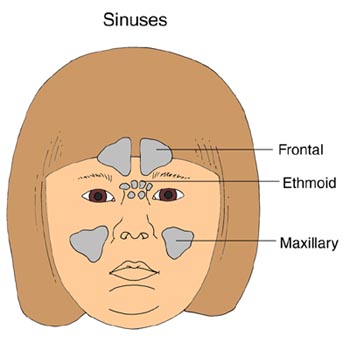Sinusitis | Symptoms & Causes
What are the symptoms of sinusitis?
The symptoms of sinusitis depend on the age of the child. The following are the most common symptoms of sinusitis. However, each child may experience different symptoms.
In younger children, symptoms may include:
- runny nose
- lasts longer than seven to 10 days
- discharge is usually thick green or yellow, but can be clear
- nighttime cough
- occasional daytime cough
In older children and adults, symptoms may include:
- runny nose or cold symptoms lasting longer than seven to 10 days
- drip in the throat from the nose
- headaches
- facial discomfort
- bad breath
- cough
- fever
- sore throat
- swelling around the eye, often worse in the morning
What causes sinusitis?
Sometimes, a sinus infection happens after a child has an upper respiratory infection (URI) or common cold. The URI causes inflammation of the nasal passages that can block the opening of the paranasal sinuses and result in a sinus infection. Allergies can also lead to sinusitis because of the swelling of the nasal tissue and increased production of mucus. There are other possible conditions that can block the normal flow of secretions out of the sinuses and can lead to sinusitis including the following:
- abnormalities in the structure of the nose
- enlarged adenoids
- diving and swimming
- infections from a tooth
- trauma to the nose
- foreign objects stuck in the nose
- cleft
When the flow of secretions from the sinuses is blocked, bacteria may begin to grow. This leads to a sinus infection, or sinusitis. The most common bacteria that cause sinusitis include the following:
- streptococcus pneumonia
- haemophilus influenzae
- moraxella catarrhalis
Sinusitis | Diagnosis & Treatments
How do we diagnose sinusitis?
In addition to a complete medical history and physical examination, doctors may use these diagnostic procedures:
- cultures from the nose or sinus fluid: laboratory tests that involve the growing of bacteria or other microorganisms to aid in diagnosis
- sinus x-rays: diagnostic test that uses invisible electromagnetic energy beams to produce images of internal tissues, bones, and organs onto film
- computerized tomography (CT or CAT scan): a diagnostic imaging procedure that uses a combination of x-rays and computer technology to produce cross-sectional images (often called "slices"), both horizontally and vertically, of the body. A CT scan shows detailed images of any part of the body, including the bones, muscles, fat, and organs. CT scans are more detailed than general x-rays.
- blood tests
How do we treat sinusitis?
Treatment of sinusitis may include the following:
- antibiotics, as determined by your child's physician (antibiotics are usually given for 10 to 14 days, and sometimes longer)
- acetaminophen (for pain or discomfort)
- use of a cool mist humidifier in your child's room
- nasal drops
Decongestants and antihistamines may not help the symptoms of sinusitis.

 Sinusitis is an infection of the sinuses near the nose. The sinuses are cavities or air-filled pockets near the nasal passage. Like the nasal passage, the sinuses are lined with mucous membranes. There are four different types of sinuses:
Sinusitis is an infection of the sinuses near the nose. The sinuses are cavities or air-filled pockets near the nasal passage. Like the nasal passage, the sinuses are lined with mucous membranes. There are four different types of sinuses:
